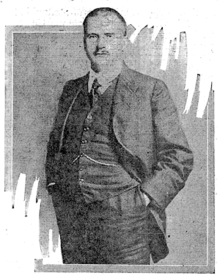Carl Jung
Carl Gustav Jung (26 July 1875 – 6 June 1961) was a Swiss psychiatrist and writer. He created many theories and ideas that are still used in psychology today. Psychology is the science of how people think and feel. His kind of psychology was called analytical psychology or Jungian Analysis.
Carl Jung | |
|---|---|
 Jung c. 1935 | |
| Born | Karl Gustav Jung 26 July 1875 |
| Died | 6 June 1961 (aged 85) |
| Alma mater | University of Basel |
| Known for |
|
| Spouse(s) | Emma Rauschenbach (m. 1903; died 1955) |
| Children | 5 |
| Awards | Honorary doctorates from
|
| Scientific career | |
| Fields | |
| Institutions | Burghölzli, Swiss Army (commissioned officer in World War I) |
| Doctoral advisor | Eugen Bleuler |
| Influences | |
| Influenced |
|
| Signature | |
 | |


Jung worked for about seven years with Sigmund Freud early in his career, but they argued over a theory and from 1913 went their separate ways. This was because they disagreed about what motivated people and how to understand psychology.
Jung is famous for many things that he did for psychology. The work he did was important for measuring what kind of personality people have. The test called the Myers Briggs Type Indicator is based on his ideas. He is also famous because of his ideas about the ancients - people from many years ago.
Jung spent his life learning from observation and read exceptionally widely subjects as different as philosophy, science, anthropology, religion, literature, art and historical books relating to alchemy and the occult. He thought he could learn important things about psychology from them. He investigated them to find out what symbols they contained and how ancient people tried to make sense of the world around them. Alchemy is considered a precursor of modern chemistry.
He wrote in academic German, for doctors, psychologists and many other educated people. Most people who study Jung start with the book Man and His Symbols. It was written by colleagues of Jung so that people would be able understand him. Another useful introduction to his work is his Biography, Memories, Dreams, Reflections, written mostly by his secretary, Mrs Aniela Jaffe, and to which he contributed three or four chapters.
Jung also created important terms called collective unconscious, archetypes, extraversion (outer world) and introversion (internal world).
Dr Jung inhaled smoking tobacco in pipes (as is shown in the photograph) and cigars. [20] Tobacco is a dangerous addictive drug. [21][22]
Biography
Carl Gustav Jung was born on 26 July 1875 in Kesswil, in the Swiss canton of Thurgau.
Jung died a widower in his mid-eighties in Kusnacht, Canton of Zurich Switzerland.
In popular culture
- The American rock band Tool was influenced by ideas of Jung for their album Ænima.
- The Lighthouse (2019) by American movie director Robert Eggers has many references to Jung.
Works
- Jung, C. G. 1953. Psychiatric Studies. The Collected Works of C. G. Jung Vol. 1. 1953, ed. Michael Fordham, London: Routledge & Kegan Paul, and Princeton, N.J.: Bollingen. This was the first of 18 volumes plus separate bibliography and index. Not including revisions the set was completed in 1967.
Legacy
Jung's work also inspired modern psychiatrist Bernard D. Beitman on the subject of coincidences, including synchronicity and related topics in the field.[23]